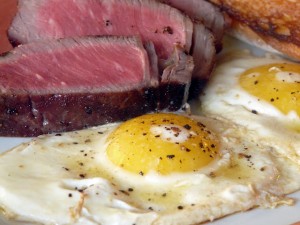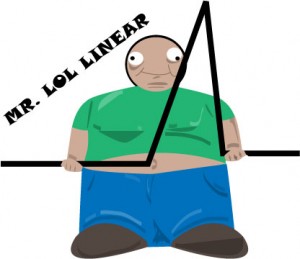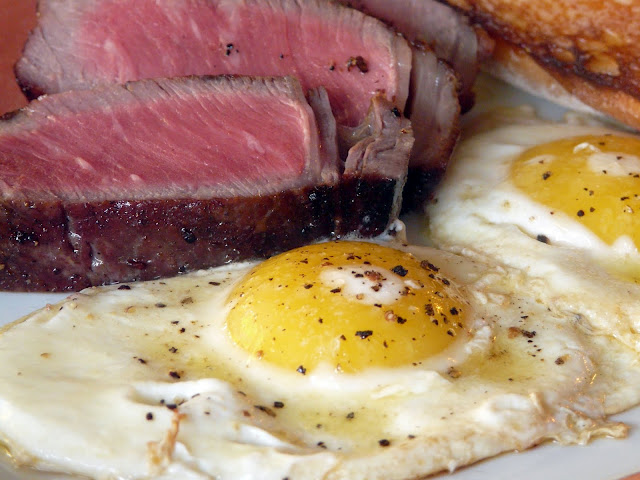For a long time, people ate six meals per day and the enjoyed every second of doing so. Lunking around Tupperware containers was a badge of honor, symbolizing a dedication to health. Then came intermittent fasting. Tupperware?Obsessive eating habits? So not cool. When I first got into the game I devoutly counted every calorie I [...]
 For a long time, people ate six meals per day and the enjoyed every second of doing so. Lunking around Tupperware containers was a badge of honor, symbolizing a dedication to health. Then came intermittent fasting. Tupperware?Obsessive eating habits? So not cool.
For a long time, people ate six meals per day and the enjoyed every second of doing so. Lunking around Tupperware containers was a badge of honor, symbolizing a dedication to health. Then came intermittent fasting. Tupperware?Obsessive eating habits? So not cool.
When I first got into the game I devoutly counted every calorie I ate. It’s an obsessive lifestyle that I don’t wish upon anyone. But the past is important. The only reason I am nutritionally sound now is because I slaved over every calorie years ago. And overall, I think everyone that is locked in on their body composition has, at some point, gone through the same obsessive-calorie-counting-food-weighing phase.
So instead of blabbling that I don’t count calories or weigh food, the truth is that I used to, and it contributed to who I am. I know eggs have 70 – 90 kcalories and 1/4 cup of oatmeal is 150 kcalories. And if you’re ignorant of these nuances, maybe you need more obsession. It’s the four stages of learning, and you can’t jump from conscious incompetence to unconscious competence.
No, because after years of doing it slavishly and trying all sorts of eating styles, I’ve got a really, really good idea of how my body reacts to foods. I’m really tuned into what’s going on so I don’t need to do that anymore. But I couldn’t have gotten this way without keeping records and doing the experiments.
– Jon Call (Jujimufu) in response to weighing food
The clean bulk
A few years ago, the consensus was that the clean bulk—gaining muscle without fat—was impossible. But since, the consensus changed. An idea still proliferates, however, that pancakes, maple syrup, and total disregard for body composition are keys to solid mass gain. But muscle creation isn’t expedited by an over ingestion of nutrients. If eating 3000 kcalories builds muscle, 6000 kcalories isn’t going to build twice as much muscle.
There’s an old adage about muscle growth being akin to laying bricks. Assuming a fixed number of workers, more bricks yield more building to a point. Once the workers have enough bricks to keep busy all day, sending more won’t lead to more output. So if we can only build ten pounds of muscle per year (plus or minus five to ten pounds for beginning and advanced trainees), trying to jam all ten pounds into a three month “bulk” window is silly. Even worse, fat cells (usually created during a “bulk”) are permanent. They shrink, but never really “dissolve.”
One reason for the popularity of the clean bulk comes from Martin Berkhan of Leangains.com, who regularly posts client updates showcasing the ability to get big and strong without getting fat and ugly. Martin is a pioneer of intermittent fasting, which refutes the superiority of a higher meal frequency. As I mentioned in Solutions for the Skinny Fat Ectomorph Part II, I’ve settled into intermittent fasting and carb cycling (a bastardization of Leangains) and it’s the basis of the strategy explained below, even though I’ve seen gains with both frequent and infrequent feedings.
Personally, I think most fitness professionals cling to the intermittent fasting boat out of necessity. Planning and pre-cooking six meals every day, seven days of the week becomes mentally taxing. The encouraging aspect of intermittent fasting and carbohydrate cycling, however, is that it better manipulates hormones. Hormones control both building muscle and losing fat. The specifics are complex, but the premise is simple: build muscle when you’re best suited for muscle growth and combat fat accumulation with you’re not suited for muscle growth.
The ins and outs
Partitioning describes how well the body handles excess calories. The guys mentioned in Solutions for the Skinny Fat Ectomorph Part I are good partitioners. Good partitioners have a hard time gaining fat, and gaining muscle is all about sacking up and eating.
For a skinny fat ectomorph, sacking up and eating leads to sacking up around the waist. We are on the low end of the partitioning totem pole for two reasons. First, genetics and hormones. Second, we have a judgmental eye when it comes to self body composition evaluation. We obsess over the slightest subjective imperfections, as mentioned in Part I. This can negatively affect hormone levels. How well partitioning goes depends — in general — on how hormones are working.
Carbohydrate cycling manipulates insulin — a storage hormone usually released in response to eating carbohydrates. A generalization is that when insulin levels are high, the body is prone to “build” and “store” things. So when insulin spikes, fat intake should be low to avoid its storage.
Again, that’s a generalization. Carbohydrate cycling can get complex, turning people away from its use. But by sticking to a few basic rules, it’s not complicating. The jist is this: more carbs, less fats, and enough protein on training days; less carbs, more fats, and more protein on rest days. And to get a little more specific:
Training Days
- High protein intake
- Mid-High carbohydrate intake
- Trace fat intake
- At least one gram of protein per pound of body weight
- Leaner cuts of meat
- Carbohydrate intake around one to three grams per pound of body weight
Off Days
- High(er) protein intake
- Mid-High fat intake
- Trace carbohydrate intake
- Carbohydrate intake comes from cruciferous vegetables
- Fattier cuts of meat allowed
- One to 1.5 grams of protein per pound of body weight
- Less than 100 grams of carbohydrates
For the specifics, and how to structure the intermittent fasting philosophy around your training schedule and daily life, check out the Leangains Guide. There’s no need to plagiarise Martin’s fantastic body of work. Below, however, is my personal adaptation and overall structure on how I use intermittent fasting.
Wave your way to gains
Building muscle is a long term process. You don’t suddenly add one pound of muscle to your frame after eating turkey legs, corralling wenches, and downing some mead. It’s not an “either-or” process. You’re not “either” building muscle “or” losing fat.

The goal of bulking is to linearly gain weight and then linearly lose the fat that accompanied the journey. The rationale is that during the “bulking” period you’re optimizing the ability to gain muscle. And truly, you are. You’re in a caloric surplus and you’re telling the body it will be fed plentifully. But the body isn’t a linear creature.
When gaining muscle while minimizing fat, there are no straight lines or steep climbs. Instead, there are small waves that gradually increase in gradient over time. So every day is an experiment. Every day can vary. Everyday you can signal your body to do different things. You can bulk one day and cut the next. It works like this: If you wake up feeling super lean and ripped, eat more. If you wake up feeling puffy for a few consecutive days, eat less. Daily caloric intake depends on how you feel. Consider this nutrient autoregulation.
 A generally accepted caloric increase for building muscle is 500 kcalories above maintenance. Now, “maintenance” level will vary as not one equation can predict everyone’s metabolic rate. But a gross formula is multiplying your body weight by anything from thirteen to sixteen. Here’s an example:
A generally accepted caloric increase for building muscle is 500 kcalories above maintenance. Now, “maintenance” level will vary as not one equation can predict everyone’s metabolic rate. But a gross formula is multiplying your body weight by anything from thirteen to sixteen. Here’s an example:
Body Weight = 200 pounds, 90.7 kilos
x 13
Maintenance Intake = 2600 kcalories
Note: I’m guessing this equation assumes a relatively lean body fat. When comparing two people of the same weight, the person with more muscle and less fat will have a higher metabolic need. This little nugget is precisely why relying on calculators is difficult and why I prefer coming to a “maintenance” level by eating a set amount of food for a week or two and seeing how the body reacts. I’d set a baseline with thirteen first and move up from there.
Instead of sticking the maintenance level day in and day out, the idea is to fluctuate the intake depending on both training status and subjective feel. Think of it as daily, yet controlled, mini bulking and cutting cycles.
If you’re already at a comfortable body fat level…
- Eat an extra 500 kcalories on your training days. If, after one week, you are still lean and mean, slowly add more kcalories on your training days.
- Keep your rest day calorie level constant. But if you ever feel puffier over a four or five day span, keep your training day calories to 500 above maintenance (at most), and drop your rest day intake to 500 kcalories below maintenance.
- If this doesn’t get you leaner in a few days, drop your training day calories to maintenance and keep the 500 deficit on rest days. But always try lowering the rest day 500 kcalories before lowering training day kcalories.
- Training frequency can vary, but have no more than three to four “heavy” sessions for high carbohydrate feedings. In general, you want to save these for the lifts and body parts that are lagging to ensure they will be fed accordingly. So if you want bigger shoulders, follow an intensive pressing session with a high carbohydrate day.
- Just because you train doesn’t mean you need to carb you face off. Just understand the training days that occur outside of the three or four high carbohydrate days will be best suited for strength development, not size.
If you’re leaning out…
- Keep the 500 kcalorie deficit on rest days.
- Stay at maintenance on training days.
- If you’re struggling to lose one pound per week, then — and only then — drop your training day calories down 500. Never further.
- Keep two to three heavy training sessions per week and use these days as your high carbohydrate days. (Similar to the strategy mentioned above.)
The more precise version of the above advice…
- Body weight x 13-16 = maintenance.
- On training days, intake maintenance x 1.1 or 1.2.
- Rest days, if feeling puffy, go for maintenance x 0.8 or 0.9.
A note on food types:
There are a lot of philosophies that dismisses gluten, dairy, and other foods. These kind of debates are outside of the scope of this article. My advice: experiment. Some people feel awesome after eliminating gluten. Some notice no difference. I’m a fan of the old school bodybuilding staples. Meats. Fish. Eggs. Vegetables. Fruits. Potatoes. Oats. Rice. Beans. Nuts. Dairy (if tolerable).
Carbohydrates peri-workout
The age of superultratectonicperi-workout nutrition is over. You don’t need to gorge on liquid sugar pre-workout to refuel your glycogen (it’s filled long before the immediate pre-workout hours). Likewise, you don’t need a Super Mass Gainer Pro Z X Grade post-workout shake.
Following Leangains, I’m a fan of working out in a fasted state after the ingestion of BCAAs. (Although for a few months now I haven’t used them and I’ve yet to notice much.) Post workout, no shakes are required. Just a wholesome carbohydrate dense meal. Precision Nutrition, another damn good nutrition resource, also recommends secluding most carbs to the post-workout window (especially when trying to lose fat).
Hormones and fasting
Warning: If you don’t have a solid grasp on the above nutritional concepts, below will only confuse you. But discussing this is in the best interest of everyone reading, and I feel it will be popping up in the future. Just another issue to think and tinker with. For the most part, however, the following section is broscience. Proceed with caution.
Fasting can boost growth hormone and may do the same with testosterone. When both of these hormones are churning, lipolysis (breakdown of fat) is primarily rocking to fuel the body. The moment insulin surges, however, both testosterone and growth hormone levels fall. Theoretically, ingesting a monsoon of carbohydrates post-workout kills the workout enduced surge of growth hormone and testosterone . So there’s compelling evidence for saving the carbohydrates until hours after the workout. After all, feasting later in the day may be better for fat loss. And about the immediate post-workout refuel — there might not be a need. Have you ever noticed that, after a workout — for the most part — you’re not overly hungry?
The problem with making this an absolute is that there are many factors to consider. By carbohydrate cycling and fasting, you’re already benefiting from elevated growth hormone and testosterone levels through out the day. And because you’re limiting carbohydrate intake on rest days, your body might better utilize post-workout carbohydrates.
So if you don’t carb cycle or fast, avoiding carbohydrates in an eight hour window (-+ 4 hours before and after workout) may be your only shot to bask in elevated growth hormone and testosterone levels. In this case, a good post-workout meal would be eggs and meats with trace carbohydrates from vegetables or something similar.
Odds and ends
There are a lot of nutrition programs and protocols out there. Truthfully, most of them probably work to certain degrees. For the skinny fat ectomorph looking to lose weight with no regard for retaining muscle mass, detailed nutrition isn’t necessary. It’s more about reducing overall caloric intake and jacking physical activity through the roof. Understand, however, that this method tends to take muscle mass with it (as it does for most people without the use of steroids). But if that’s the goal, that’s the goal. Skinny fat ectomorphs don’t have good muscle retention genes when nutrient deprived. It’s a tradeoff you have to be willing to take.
The better way to go about both losing fat and gaining muscle is the long term training approach mixed with mini periods of bulking and cutting – otherwise known as nutrient autoregulation – by fluctuating hormones through dietary manipulation that concide with your training days.
I need your help

Skinny fat brethren, I need your help. This article is all over the place. I know there are loose ends that remain loose. But after working on this article for over twelve hours, I simply don’t have “it” in me anymore. Whether it be in the comments, Facebook, Twitter, or whatever else, I need your feedback. Tell me what I’m missing and what needs more detail.
To give you an idea of what’s to come, specific topics like GOMAD and other popular principles are in the wing. If you have any others, request them. Also, I plan on writing a post about my specific nutritional strategy (eating only twice per day) and a “storytellers” version of the information above (I’m going to tell a story of a guy or gal using these principles so you can see what a typical day would look like). Lastly, I’m thinking of giving away one or two free coaching spots for my readers. So show your face and give me some feedback. I’d appreciate it.
+++++
Other articles in the series:
- Solutions for the Skinny-Fat Ecto, Part I – The Basics
- Solutions for the Skinny-Fat Ecto, Part II – My Story
- Solutions for the Skinny-Fat Ecto, Part III – Training
=====
Accompanying resource: The Skinny-Fat Solution
